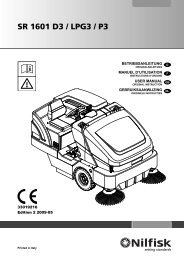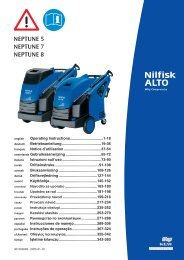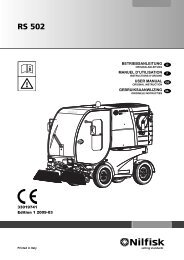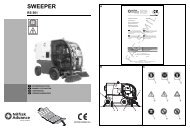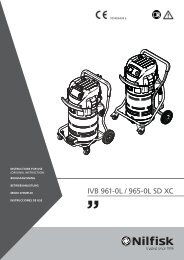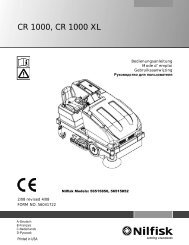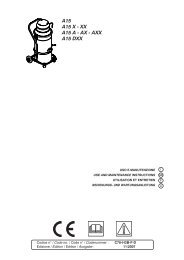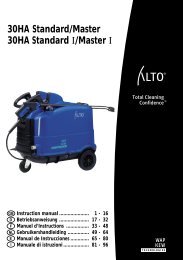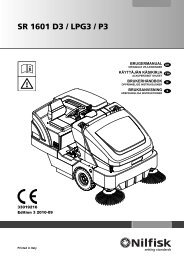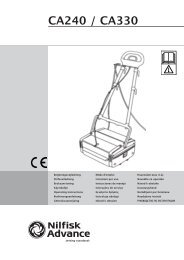3707 - 3707/10 3907 - 3907W - 3907/18 - Nilfisk PARTS
3707 - 3707/10 3907 - 3907W - 3907/18 - Nilfisk PARTS
3707 - 3707/10 3907 - 3907W - 3907/18 - Nilfisk PARTS
Create successful ePaper yourself
Turn your PDF publications into a flip-book with our unique Google optimized e-Paper software.
Mod. <strong>3707</strong> - <strong>3707</strong>/<strong>10</strong> - <strong>3907</strong> - <strong>3907</strong>W - <strong>3907</strong>/<strong>18</strong> - <strong>3707</strong>/<strong>10</strong>C - <strong>3707</strong>/<strong>10</strong>K1<br />
<strong>3707</strong>/<strong>10</strong>B1 - <strong>3907</strong>/C - <strong>3907</strong>/K1 - <strong>3907</strong>/B1 - <strong>3907</strong>W/C - <strong>3907</strong>W/K1<br />
<strong>3907</strong>W/B1 - <strong>3907</strong>/<strong>18</strong>/C - <strong>3907</strong>/<strong>18</strong>/K1 - <strong>3907</strong>/<strong>18</strong>/B1<br />
motore di aspirazione alla camera<br />
filtrante, compreso il tratto<br />
ricoverato all’interno della<br />
carenatura e che si raccorda<br />
all’unità aspirante.<br />
In caso di lesioni, rotture o in<br />
caso di anomalo accoppiamento<br />
del tubo sui bocchettoni di<br />
raccordo, procedere alla sostituzione<br />
del tubo “1”.<br />
Quando l’aspiratore viene utilizzato<br />
per aspirare materiali<br />
collosi, verificare che non si siano<br />
provocate occlusioni o strozzature<br />
nel percorso dell’aria aspirata.<br />
Verificare altresì lo stato del tubo<br />
di aspirazione “2”.<br />
Per la sua stessa funzione è la<br />
parte che viene maggiormente<br />
movimentata, a volte anche in<br />
malo modo ed è la parte dell’aspiratore<br />
maggiormente a<br />
contatto dei detriti da aspirare.<br />
Per questo motivo il tubo di aspirazione<br />
“2” è molto esposto ad<br />
usure e rotture.<br />
Controllarlo quindi periodicamente<br />
e procedere alla sua immediata<br />
sostituzione in caso di<br />
sua non integrità.<br />
Per smontare il tubo “2” è sufficiente<br />
premere il piastrino “4”<br />
presente sul bocchettone “3”<br />
come indicato in fig. 8.5.8.<br />
Quando vengono trattati materiali<br />
collosi, controllare le possibili<br />
occlusioni che possono intervenire<br />
lungo il tubo “2”, nel<br />
bocchettone “3” e sul deflettore<br />
presente nella camera filtrante.<br />
Per la pulizia raschiare dall’esterno<br />
del bocchettone e rimuovere<br />
il materiale depositato come indicato<br />
in fig. 8.5.8.<br />
8.5.8 - Verificare lo stato<br />
della ventola aspirante<br />
(fig.8.5.9)<br />
Quando l’aspiratore viene utilizzato<br />
su materiali collosi e si è<br />
proseguito il lavoro sebbene il<br />
filtro fosse danneggiato, oltre al<br />
controllo del tubo e del deflettore<br />
all’interno della camera filtrante<br />
occorre verificare la pulizia<br />
della ventola aspirante “1”.<br />
Un eventuale deposito di polvere<br />
può provocarne uno sbilanciamento<br />
della ventola producendo<br />
anomale vibrazioni dell’aspiratore<br />
e precoce usura del<br />
cuscinetto.<br />
In questi casi richiedere l’intervento<br />
dell’assistenza tecnica<br />
chamber. Check that it is correctly<br />
fixed.<br />
Do not forget to inspect the hidden<br />
section inside the casing<br />
that joins to the suction unit.<br />
Hose “1” should be replaced if<br />
damaged or broken or if the<br />
hose couplings to the spigot fittings<br />
are faulty.<br />
When the vacuum is used to<br />
suck up sticky materials, check<br />
that there is no clogging or throttling<br />
along the entire air suction<br />
line.<br />
Also check the condition of suction<br />
hose “2”.<br />
Owing to its function, this is the<br />
part that is most greatly subjected<br />
to movement. It is also<br />
the part of the vacuum that is in<br />
contact with the sucked waste<br />
most.<br />
For this reason, suction hose “2”<br />
is highly exposed to wear and<br />
breakage.<br />
It should be periodically checked<br />
and immediately replaced if<br />
damaged.<br />
To remove hose “2”, just press<br />
plate “4” on outlet “3” as indicated<br />
in fig. 8.5.8.<br />
When sticky materials are<br />
treated, check for possible clogging<br />
along pipe “2”, in outlet “3”<br />
and on the baffle in the filtering<br />
chamber.<br />
Scrape outside the outlet and<br />
remove the deposited waste as<br />
indicated in fig. 8.5.8.<br />
8.5.8 - Checking the condition<br />
of the suction<br />
fan (fig. 8.5.9)<br />
When the vacuum is used with<br />
sticky materials and work has<br />
proceeded even though the filter<br />
is damaged, besides checking<br />
the pipe and baffle inside the<br />
filter chamber, it will also be necessary<br />
to clean suction fan “1”.<br />
Dust deposits could unbalance<br />
the fan, creating abnormal vibrations<br />
and quickly wearing the<br />
bearings.<br />
Ask for technical assistance from<br />
CFM or one of the manufactur-<br />
-82-<br />
du moteur d’aspiration à la chambre<br />
filtrante, y compris le tronçon<br />
raccordé à l’unité aspirante<br />
(à l’intérieur du carènage).<br />
Si le tuyau est abîmé, cassé ou<br />
en cas de mauvais accouplement<br />
du tuyau sur les embouts<br />
de raccord, remplacer le tuyau<br />
“1”.<br />
En cas d’aspiration de matières<br />
collantes, vérifier qu’il n’y a pas<br />
d’occlusions ou d’étranglements<br />
le long du parcours de l’air aspiré.<br />
Vérifier l’état du tuyau d’aspiration<br />
“2”.<br />
C’est le tuyau que l’on déplace<br />
le plus par sa fonction et parfois<br />
même que l’on maltraite le plus.<br />
C’est la partie le plus en contact<br />
avec les déchets à aspirer.<br />
Pour cette raison le tuyau d’aspiration<br />
“2” est particulièrement<br />
exposé à l’usure et aux ruptures.<br />
Contrôler périodiquement et le<br />
remplacer immédiatement s’il<br />
est en mauvais état.<br />
Pour démonter le tuyau “2” il<br />
suffit de presser le verrou “4” de<br />
l'embouchure “3” comme indiqué<br />
dans la fig. 8.5.8.<br />
En cas d’aspiration de matières<br />
collantes contrôler le long du<br />
tuyau “2”, dans l’embout “3” et<br />
sur le déflecteur de la chambre<br />
filtrante car ils auront tendance<br />
à s’obstruer.<br />
Pour le nettoyage racler de l’extérieur<br />
de l’embouchure et enlever<br />
la matière qui s’est déposée<br />
comme indiqué dans la fig. 8.5.8.<br />
8.5.8 - Vérifier l’état du<br />
ventilateur aspirant<br />
(fig. 8.5.9)<br />
Quand l’aspirateur est utilisé sur<br />
des matières collantes et que le<br />
travail a été continué bien que le<br />
filtre soit endommagé, en plus du<br />
contrôle du tuyau et du déflecteur<br />
à l’intérieur de la chambre<br />
filtrante il faut vérifier le nettoyage<br />
de la turbine aspirante “1”.<br />
Le dépôt de poussière peut provoquer<br />
un déséquilibre du ventilateur<br />
en produisant des anomalies,<br />
des vibrations de l’aspirateur,<br />
et une usure précoce du<br />
roulement.<br />
Dans ces cas demander l’intervention<br />
de l’assistance techni-<br />
© C.F.M. S.p.A.<br />
Tutti i diritti riservati / All rights reserved<br />
Tous droits réservés / Alle Rechte vorbehalten<br />
korrekte Befestigung von<br />
Schlauch “1” zu prüfen, dir den<br />
Saugmotor mit der Filterkammer<br />
verbindet, einschließlich des<br />
Teils, das sich innerhalb der Verkleidung<br />
befindet und an die<br />
Saugeinheit angeschlossen wird.<br />
Bei Beschädigungen, Brüchen<br />
oder falscher Sitz des Schlauchs<br />
an die Anschlußstutzen ist der<br />
Schlauch “1” zu ersetzen.<br />
Wenn der Industriesauger benutzt<br />
wird, um klebrige Materialien<br />
zu entfernen, ist sicherzustellen,<br />
daß auf der Saugstrecke<br />
keine Verstopfungen oder Engstellen<br />
vorliegen.<br />
Außerdem den Zustand des<br />
Saugschlauches “2” prüfen da<br />
schon wegen der Funktion ist<br />
das der Teil des Gerätes, der<br />
am häufigsten beansprucht wird.<br />
Aus diesem Grund ist der Saugschlauch<br />
“2” am evtl. starken<br />
Verschleiß und Beschädigungen<br />
ausgesetzt.<br />
Er muß daher regelmäßig geprüft<br />
werden, um ihn sofort zu<br />
ersetzen, wenn er nicht mehr in<br />
Ordnung ist.<br />
Um den Schlauch “2” abzubauen,<br />
braucht man nur auf das<br />
Plättchen “4” drücken, das auf<br />
dem Stutzen “3” vorhanden ist,<br />
so wie in Abb. 8.5.8.<br />
Wenn klebrige Materialien gesaugt<br />
wurden ist nach mögliche<br />
Verschlußstellen zu suchen, die<br />
längs des Schlauchs “2”, im Stutzen<br />
“3” und auf dem Leitblech in<br />
der Filterkammer vorliegen können.<br />
Zur Reinigung den Stutzen von<br />
innen abkratzen und das abgelagerte<br />
Material entfernen, so<br />
wie es in Abb. 8.5.8 gezeigt ist.<br />
8.5.8 - Prüfung des Zustands<br />
des Lüfterrades<br />
(Abb. 8.5.9)<br />
Wenn der Industriesauger für<br />
klebriges Material verwendet<br />
wurde obwohl das Filter beschädigt<br />
war, dann sind nicht nur der<br />
Schlauch und das Leitblech im<br />
Inneren der Filterkammer zu prüfen,<br />
sondern ist auch notwendig<br />
eine Wartung des Lüfterrades “1”.<br />
Etwaige Staubablagerungen<br />
können dazu führen, daß das<br />
Lüfterrad eine Unwucht aufweist<br />
und zum vorzeitigen Verschleiß<br />
des Lagers führen.<br />
In diesen Fällen wendet man<br />
sich an den Kundendienst der



